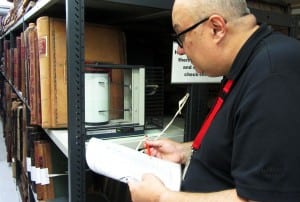Making the archives greener
Posted on by Fay Curtis.
Allie Dillon, Senior Archivist (Public Services)
 At Bristol Archives we care for the city’s archives – over ten miles of shelving containing documents dating back as far as the 12th century – by carefully managing the storage conditions in our strongrooms. We recently changed the way we manage this environment and we’ve been highly commended for our new approach in the Collections Practice category of the 2014 Collections Trust Awards.
At Bristol Archives we care for the city’s archives – over ten miles of shelving containing documents dating back as far as the 12th century – by carefully managing the storage conditions in our strongrooms. We recently changed the way we manage this environment and we’ve been highly commended for our new approach in the Collections Practice category of the 2014 Collections Trust Awards.
To preserve archive collections, it’s important that documents are not allowed get too dry, which would cause them to become brittle, or too damp, which would cause them to expand and even go mouldy. Likewise, if they are too warm, certain inks might begin to run, or if they are too cold, wax seals might start to disintegrate.
Until recently, a British Standard (BS 5454:2000) gave strict guidance which meant that air-conditioning was needed to store archives within acceptable ranges of temperature and humidity. This is an expensive and time-consuming process: our air-conditioning system cost Bristol City Council thousands of pounds to run and maintain each year.
In 2012, however, new standards were issued (PD 5454:2012 and PAS 198:2012), aimed at providing optimum conditions whilst reducing the economic and environmental costs of caring for collections.
Our former Archives Manager Richard Burley and our Conservator David Singleton immediately began to investigate alternative ways to control our strongroom environment without risking damage to the archives.
The collections are housed in B Bond Warehouse, where our strongrooms occupy four floors on the western side of the building, surrounded on other floors by public spaces and council offices. As an early 20th century tobacco warehouse, B Bond provides ideal storage for heavy, bulky archive collections. Richard and David’s experiments found that the building should also be able to provide suitable environmental conditions with minimal intervention.
Together, they calculated that the building has enough wasted heat from the other floors to control conditions in our storage areas. With scientific input and enthusiastic support from Tim Padfield, a freelance preventative conservator and buildings specialist, they made the bold decision to turn off the air-conditioning. By also sealing up all the windows (to prevent draughts and heat loss), they aimed to rely on the natural conditions of the building to create a stable environment.
Almost two years into the experiment, we have found that this simple strategy, against all previous advice and guidance, has proved highly effective. Regular monitoring shows that average temperature and humidity in all of our strongrooms has remained at appropriate levels and within the first year, we cut our energy bills by over £6,000, as well as saving on maintenance costs and considerably reducing our carbon footprint.
Our air-conditioning systems are still in place, in case changes in the weather cause the temperature or humidity to fluctuate, but so far they haven’t been needed at all.
We’re very pleased that this innovation has been recognised by the Collections Trust and David is now looking into how we can use this system to care for the other collections held by Bristol Museums, Galleries & Archives. We’re also sharing our findings with other institutions and encouraging them to experiment too.
Image credit: Neil McCoubrey